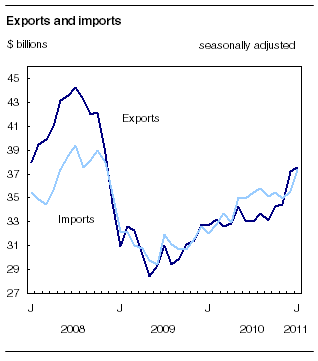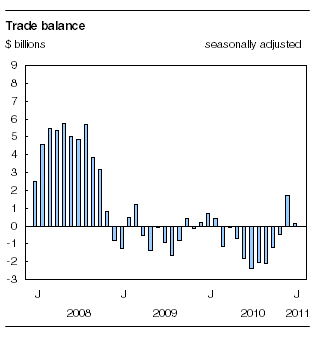Canadian international merchandise trade
Archived Content
Information identified as archived is provided for reference, research or recordkeeping purposes. It is not subject to the Government of Canada Web Standards and has not been altered or updated since it was archived. Please "contact us" to request a format other than those available.
Related subjects
-
[an error occurred while processing this directive]
Canada's merchandise imports rose 5.3% to $37.4 billion in January, led by a 16.6% increase in volumes of automotive products. Overall, import volumes rose 5.5% while prices declined 0.2%. Import volumes have been trending upward since March 2009.

Note to readers
Merchandise trade is one component of Canada's international balance of payments, which also includes trade in services, investment income, current transfers as well as capital and financial flows.
International merchandise trade data by country are available on both a balance of payments and a customs basis for the United States, Japan and the United Kingdom. Trade data for all other individual countries are available on a customs basis only. Balance of payments data are derived from customs data by making adjustments for characteristics such as valuation, coverage, timing and residency. These adjustments are made to conform to the concepts and definitions of the Canadian System of National Accounts.
Data in this release are on a balance of payments basis, seasonally adjusted in current dollars. Constant dollars are calculated using the Laspeyres volume formula.
Revisions
In general, merchandise trade data are revised on an ongoing basis for each month of the current year. Current year revisions are reflected in both the customs and balance of payments based data. Revisions to customs based data for the previous year are released on a quarterly basis. Revisions to balance of payments based data for the three previous years are released annually in June.
Factors influencing revisions include late receipt of import and export documentation, incorrect information on customs forms, replacement of estimates produced for the energy sector with actual figures, changes in classification of merchandise based on more current information, and changes to seasonal adjustment factors.
Revised data are available in the appropriate CANSIM tables.
Automotive products and energy products led the growth in the value of imports. A significant increase was also recorded in imports of machinery and equipment.
Following a 7.9% increase in December, exports rose 0.8% to $37.5 billion in January. Export volumes increased 1.0% while prices edged down 0.1%. Volumes of automotive products, up 18.4%, were the main factor behind the gain in exports.
Exports of industrial goods and materials as well as energy products also increased during the month. In contrast, exports of machinery and equipment declined, thereby moderating the overall gain.
As a result, Canada's trade surplus narrowed from $1.7 billion in December to $116 million in January.
Imports from the United States rose 6.5%, reflecting strong gains in imports of automotive products while exports, up 3.3%, increased for a fourth consecutive month. Consequently, Canada's trade surplus with the United States declined from $4.3 billion in December to $3.8 billion in January.
After a large gain in December, exports to countries other than the United States fell 5.2% in January. Conversely, imports increased 3.4%. Hence, Canada's trade deficit with countries other than the United States increased from $2.6 billion in December to $3.6 billion in January.

Imports reach their highest level since November 2008
Imports of automotive products rose 16.2% to $6.4 billion in January, the result of higher volumes as prices fell slightly. Imports of trucks (+35.8%) led the gain, followed by imports of motor vehicle parts. Despite winter storms and part shortages that adversely affected some manufacturers in January, imports of motor vehicle parts rose 13.9%. Imports of passenger autos also increased during the month.
Imports of energy products increased 13.8% to $4.2 billion, the highest level since October 2008. Although prices of energy products were up in January, the gain in the sector was largely the result of increases in volumes. Imports of crude petroleum rose 12.4%, a third consecutive monthly gain. Imports of petroleum and coal products increased, mostly as a result of higher imports of gasoline.
Imports of machinery and equipment increased 1.8% to $10.0 billion, as volumes rose. Volumes have been trending upwards since October 2009. Imports of aircraft, engines and parts were the main factor behind the gain in the sector. Imports of other communication and related equipment also increased during the month.
Imports of industrial goods and materials declined 0.8% to $7.6 billion, as prices fell 2.0%. Imports of metals and metal ores, at a record high in December, largely accounted for the decrease in January, as imports of precious metals and metal in ores fell. Higher imports of chemicals and plastics moderated the decline in the sector.
Exports increase for a fourth consecutive month
Exports of automotive products rose 16.3% to $5.2 billion in January, the highest value since May 2010. The gain was a result of rising volumes. Exports of passenger autos, up 22.9%, largely accounted for the growth in this sector. Exports of motor vehicle parts increased as well in January, halting two consecutive months of decline.
Exports of industrial goods and materials increased 3.8% to $9.5 billion in January, largely a result of higher prices. This represented the sixth month of increases in prices. Exports of precious metals led the growth, followed by exports of other crude non-metallic minerals. These increases were moderated by a decline in exports of metal ores in January, more specifically copper ores, following a large gain in December.
Exports of energy products rose 2.5% to $9.4 billion. Crude petroleum exports, up 5.8%, increased for a fourth consecutive month in January, albeit at a slower pace than in the previous three months. Exports of coal and other bituminous substances declined in January.
Exports of machinery and equipment fell 8.9% to $6.3 billion, with aircraft, engines and parts accounting for the bulk of the decline. Lower exports of industrial machinery, namely drilling, excavating and mining machinery, also contributed to the decrease.
Exports of agricultural and fishing products declined 7.2% to $3.2 billion, mostly reflecting lower volumes. Following a large gain in December, exports of wheat fell 15.4% in January, as volumes declined 21.0%. Wheat prices have been trending upward since April 2010.
Forestry products exports declined 7.4% to $1.9 billion. Exports of wood pulp and other wood products, which led the increase in December, fell 12.2% in January. Exports of lumber and sawmill products declined 7.6%, halting four months of increases.
Available on CANSIM: tables 228-0001, 228-0003, 228-0033, 228-0034, 228-0041 to 228-0043 and 228-0047 to 228-0057.
The merchandise imports and exports data in the following tables are presented in dollar values.
Tables 228-0001 to 228-0003: Customs and balance of payments basis, by major groups and principal trading areas for all countries; monthly, quarterly, and annual.
Table 228-0033: Imports, customs-based, by province of clearance, monthly.
Table 228-0034: Domestic exports, customs-based, by province of origin, monthly.
Tables 228-0041 to 228-0043: Customs and balance of payments basis, by sector and sub-sector, for all countries; monthly, quarterly, and annual.
The merchandise imports and exports data in the following tables are indexes (2002=100).
Tables 228-0047 to 228-0049: Balance of payments and customs-based price and volume indexes for all countries; monthly, quarterly, and annual.
Tables 228-0050 to 228-0052: Customs-based price indexes, Canada and United States trade, and Standard International Trade Classification (SITC revision 3) price indexes for all countries and United States; monthly, quarterly, and annual.
Tables 228-0053 to 228-0055: Price and volume indexes customs and balance of payments basis, by sector and sub-sector, for all countries; monthly, quarterly, and annual.
Tables 228-0056 and 228-0057: Balance of payments basis, by sector, seasonally adjusted, Fisher formula, chained 2002 dollars, for all countries; monthly and quarterly.
Definitions, data sources and methods: survey numbers, including related surveys, 2201, 2202 and 2203.
These data are available in the Canadian international merchandise trade database.
The January 2011 issue of Canadian International Merchandise Trade, Vol. 65, no. 1 (65-001-X, free), is now available from the Key resource module of our website under Publications.
Current account data (which incorporate merchandise trade statistics, service transactions, investment income and transfers) are available quarterly in Canada's Balance of International Payments (67-001-X, free).
Data on Canadian International Merchandise Trade for February will be released on April 12.
The 2010 annual review for Canadian international merchandise trade will be released on April 7.
For further information regarding Canada's international merchandise trade data, contact Statistics Canada's National Contact Centre. To enquire about the concepts, methods or data quality of this release, contact Mychèle Gagnon (613-951-0994), International Trade Division.
- Date modified:
